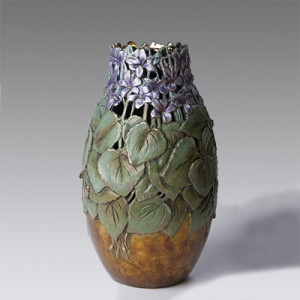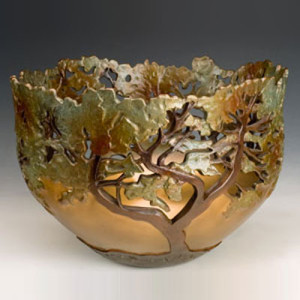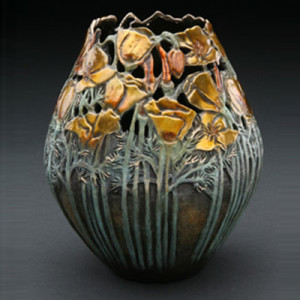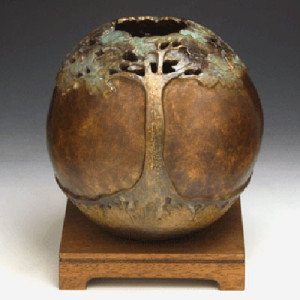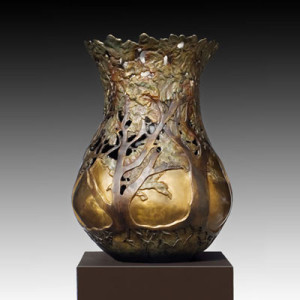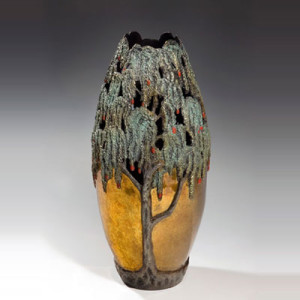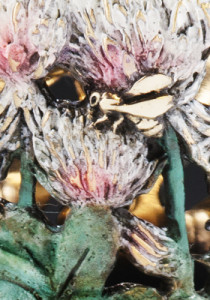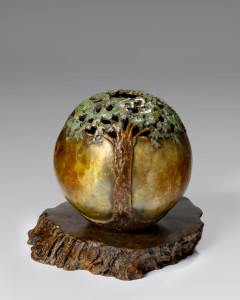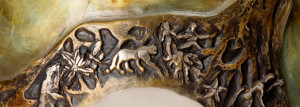Click here now to view details about our newest release, Love Blooms, inspired by the beloved wild violet plant.
Tempe Center for the Arts Green and Gray Opening
The vibrant opening of the Green and Gray exhibition at the Tempe Center for the Arts was marvelously successful Friday evening. The attendance was impressively high and continued consistently through the three hour reception. Below enjoy some images from the opening and mark your calendars to attend, if possible, before the exhibition closes on January 2, 2016. We are most grateful for the amazingly hard and capable work of the entire staff at the Tempe Center for the Arts – it is a striking and wonderful exhibit. Participating artists include: Carol Alleman, Susan Beiner,Peter Bugg, Christine Casino, Angela Cazel-Jahn,Candace Eisenfeld, Steve Gomf, Preston Graves, Jonathan Howard, Mohammed Reza Javaheri, Karen Jilly, Catherine Nash and Ellen Wagener.
Visitors explore the exhibit. Transitions II right foreground and Celestial Joy left foreground. Woodland Queens (not shown) was placed just inside the entrance.
Trinity and Gratitude are both exhibited showing the original clay vessels and the finished cast bronze Foundry Proofs. An abbreviated paper tour of the process is displayed on the wall to left.
Visitors admire Montage Abundance, Twilight Stars and the original clay version of Transitions – later enlarged to 42″ becoming Transitions II
Carol explains the symbolism of Celestial Joy and the process to interested guests
Guest admires painting by Candace Eisenfeld and Transitions II – the two works presented beautifully together
Green and Gray Exhibition at Tempe Center for the Arts
Carol has been honored with an invitation to participate in the upcoming 2015 Green and Gray exhibition at the Tempe Center for the Arts, in Tempe AZ. Carol’s participation will include retrospective pieces among the 13 Alleman works presented. The exhibition will open October 2, 2015 and run through January 9, 2016.
Free Public Reception: 6-9 pm | Oct 2 | Gallery
“This exhibition is about the world between the natural landscape and the built environment. People often associate the color green with life and the color gray with coldness. But that isn’t always the case, not all that is green is natural and not all that is gray is manmade. Each artist in this exhibition explores subjects and imagery that show where these elements of the natural and built environment merge, converge and/or conflict. Artists include: Carol Alleman, Susan Beiner, Peter Bugg, Christine Cassano, Angela Cazel-Jahn, Candace Eisenfeld, Steve Gompf, Preston Graves, Jonathan Howard, Mohammed Reza Javaheri, Karen Jilly, Catherine Nash and Ellen Wagener.”
Carol will exhibit the following works: Transitions vessel in original, hand-coiled clay form; Trinity vessel in original, hand-coiled clay form; Gratitude in original hand-coiled clay form; Transitions II (bronze); Montage Abundance (bronze); Illusion of Complexity (bronze); Seeds of Harmony (bronze); Gratitude (bronze); Trinity (bronze); Woodland Queens (bronze); Celestial Joy (bronze); and Graceful One (bronze). Companion Writings and an overview of the complete process of bringing each piece to life will be included in this retrospective exhibit.
Carol will be attending the opening reception on October 2, 2015 from 6-9 PM. Admission for the opening reception is free.
Pollination Update and Presidential Memorandum
Close -up view of honeybee on Nature’s Bounty
“Announcing New Steps to Promote Pollinator Health
Posted by John P. Holdren on May 19, 2015
Pollinators are critical to the Nation’s economy, food security, and environmental health. Honey bee pollination alone adds more than $15 billion in value to agricultural crops each year, and helps ensure that our diets include ample fruits, nuts, and vegetables. This tremendously valuable service is provided to society by honey bees, native bees and other insect pollinators, birds, and bats.
But pollinators are struggling. Last year, beekeepers reported losing about 40% of honey bee colonies, threatening the viability of their livelihoods and the essential pollination services their bees provide to agriculture. Monarch butterflies, too, are in jeopardy. The number of overwintering Monarchs in Mexico’s forests has declined by 90% or more over the past two decades, placing the iconic annual North American Monarch migration at risk.
That’s why last June, President Obama issued a Presidential Memorandum directing an interagency Task Force to create a Strategy to Promote the Health of Honey Bees and Other Pollinators. Today, under the leadership of the U.S. Environmental Protection Agency (EPA) and U.S. Department of Agriculture (USDA), the Task Force is releasing its Strategy, with three overarching goals:
Reduce honey bee colony losses to economically sustainable levels;
Increase monarch butterfly numbers to protect the annual migration; and
Restore or enhance millions of acres of land for pollinators through combined public and private action.
The Strategy released today and its accompanying science-based Pollinator Research Action Plan outline needs and priority actions to better understand pollinator losses and improve pollinator health. These actions will be supported by coordination of existing Federal research efforts and accompanied by a request to Congress for additional resources to respond to the pollinator losses that are being experienced.
Increasing the quantity and quality of habitat for pollinators is a major part of this effort—with actions ranging from the construction of pollinator gardens at Federal buildings to the restoration of millions of acres of Federally managed lands and similar actions on private lands. To support these habitat-focused efforts, USDA and the Department of Interior are today issuing a set of Pollinator-Friendly Best Management Practices for Federal Lands, providing practical guidance for planners and managers with land stewardship responsibilities.
The President has emphasized the need for an “all hands on deck” approach to promoting pollinator health, including engagement of citizens and communities and the forging of public-private partnerships. To foster collaboration, the interagency Pollinator Health Task Force will work toward developing a Partnership Action Plan that guides coordination with the many state, local, industry, and citizen groups with interests in and capacities to help tackle the challenge facing pollinators.
People of all ages and communities across the country can play a role in responding to the President’s call to action. YOU can share some land with pollinators—bees, butterflies, other insects, birds, bats—by planting a pollinator garden or setting aside some natural habitat. YOU can think carefully before applying any pesticides and always follow the label instructions. YOU can find out more about the pollinator species that live near you.
Today’s announcement marks an important step toward promoting the health of pollinators that are critically important to our economy, environment, and health.” – The Pollinator Partnership 2015
During these warm summer months, may we all remain conscious of our actions in the garden as we continue to protect and support our beloved pollinators!
Marriage of Spirit Selected for Artists for Conservation International 2015 Exhibition
Results have just been announced for the 2015 International Artists for Conservation Juried Live and Virtual Exhibition. This year, Marriage of Spirit ,on the optional bronze base, has been selected as one of 200 artworks for inclusion in the virtual exhibition. Fifteen different countries will be represented in this exhibit including Australia, Bulgaria, Canada, Guatemala, Israel, Japan, Kenya, Mexico, New Zealand, Nicaragua, South Africa, The Netherlands, UK and the USA.
The jurors for the 2015 exhibit include: John Banovich – Artist and AFC Member (USA); Steve Morvell – Artist and AFC Member (Australia); Murray Phillips – Artist and AFC Board Member (Canada); Holly Swangstu – Art Institute Director, Arizona-Sonora Desert Museum (USA); and Debra Usher – Publisher & Editor in Chief, Arabella Magazine (Canada).
Artists For Conservation (AFC) is the world’s leading group of artists supporting the environment. Founded in 1997, the non-profit organization comprises a membership of 500 of the world’s most gifted nature artists from 27 countries, across five continents. Dedicated to nurture, promote and leverage its world-class community of artists in support of our natural world, AFC drives its mission through three key programs: Art & Environmental Education; Field Work & Research; and Artist Development. We are honored to be, once again, selected for participation in this internationally renown exhibition. Visit the Artists for Conservation website for additional information and for details for attending the live exhibit to be held in Vancouver at http://www.natureartists.com.
Remembering our Beloved Pollinators
“Eight years ago, the U.S. Senate’s unanimous approval and designation of a week in June as “National Pollinator Week” marked a necessary step toward addressing the urgent issue of declining pollinator populations. The U.S. Secretary of Agriculture signs the proclamation every year. This year’s Pollinator Week will take place June 15-21, and the Pollinator Partnership has been contacting every governor’s office in America to request a state proclamation in support of the federal observance. We already have 15 signed proclamations and many more on their way from governors across the U.S. We still need the support of in-state individuals and organizations from ALABAMA, ALASKA, KANSAS, LOUISIANA, NEW YORK, and SOUTH DAKOTA. If you or someone you know is from any of these states, please ask them to submit a proclamation request online or call their governor’s office to voice their support for Pollinator Week 2015. Feel free to use the sample proclamation text available at http://pollinator.org/npw_action.htm. Please see the relevant contact information below.” – Pollinator Partnership 2015
I love that the United States has designated a National Pollinator Week. Even more, I would love if it also meant we are each taking active steps in helping to save our beloved pollinators with our actions everyday. Planting a pesticide free garden is the easiest and likely the best way to become a part of this practice. Speaking with our children and grandchildren about the habits, gifts and beauty of various pollinators is a wonderful practice they will enjoy – and one which will nurture future protection for them. I hold a particular passion for our honeybees; though each of our pollinators are indeed at risk. The honeybee however, provides us with so many of the fruits and vegetables we eat on a daily basis it feels paramount for us to be acting on their behalf now. Notice I used the word “our” rather than “the” when referring to honeybee. They are indeed ours to care for – ours to protect. They belong to each of us. They feed each of us daily. To ignore their plight may be akin to ignoring our mothers and fathers. The fact that they are so small allows us to easily completely take them for granted and forget all about the miraculous work they do on our behalf.
We can also learn a great deal about these incredible workers and allow them to offer us some deep and warm inspiration regarding the blessings of working in community. Their habits, their vision, their language, their tenacity are each profoundly amazing and inspiring attributes. Read more here.
Several years ago I created a bronze vessel specifically on behalf of protecting our honeybees: Nature’s Bounty. It is a very small piece, not unlike the honeybee. Amidst a field of white clover, one solitary honeybee visits the clover – one tiny (and difficult to find without intention) honeybee symbolic of how easy it is for us to overlook them in nature as well. The textural base of the piece was created using actual honeycomb from a hive of bees my brother tends on our family farm in PA. Each time we sell a Nature’s Bounty from the studio, we donate a portion (between 10 and 30%) of the sale to one of the organizations helping support our pollinators via education, research and other efforts. Often we support Pollinator Partnership with these donations; or an organization of the collector’s choice. Read more here.
Gratitude for always being “full”
My small yard is laden with blooms and vegetables of many kinds. I continue to try my best to keep it as desert friendly as possible, while also allowing myself the deep pleasures of seeing lovely blooms year long from the windows where I work. I have a tall shepherd’s hook which holds a beautiful bird feeder for suet. I chose the suet as an affordable manner in which to feed and enjoy the incessant company of the many birds (and especially the colorful finches) that visit. I love awakening to their chirping conversations and frequently wish I knew their language to fully participate. I wonder what exactly they are singing and chirping about with such exhuberance. I think they hold some secret wisdom I am yet to fully discover.
What I have noticed is that if I want to keep this feeder full for them at all times, it is not nearly as affordable as I intended. They can effortlessly empty it in less than a day. So, a while back, I had a conversation with them. I told them I will fill it only twice a week in warmer weather when they are able to easily find food. Twice a week equates to about $12 a month in suet. That’s reasonable on my budget. And that’s reasonable for them one would imagine. They perch along the top of the wall calling to me “the feeder is empty”. They wait. And they wait. And then they disappear (sometimes for days) until I fill it again and quickly I become the favorite feeding and visiting arena once more. Where do they go and do they really wait I wonder? They surely lose no time in noticing when I fill it again each time.
Today, while noticing the empty feeder and wall equally empty of visitors I reflect upon this. How often, I ask myself, do I too simply look for the “quick and easy” feed? How often and long do I wait for someone else to simply give me food? Do I really fully appreciate those places/people where I am effortlessly fed and delighted with conversation? And when it is not readily available, do I disappear looking for another similarly effortless experience to simply offer it to me? Or, do I then create my own delightful experience? Or, decide it is time for me to offer to another? Am I willing to sit quietly for awhile, and feed myself through the silence and quiet? Can I trust that I need no “other” to “put out the food”? It is an immense pleasure when it is so readily available, and yet there is a larger circle at work I believe. I believe there is a circle of both contribution and of receiving. Both are equal in value and in joy. And, both truly feed. I can bet those birds don’t waste any time waiting simply for “me” to feed them. I imagine they simply fly about taking where it is available, discovering many other places to find it, and perching and singing peacefully in-between. I imagine they are happy when my feeder is full and happy when it is empty as well.
Sometimes we are so easily seduced into looking for the quick fix. The quick meal. The quick company. The quick distraction. And so today I am reminded of the nourishing gifts of slowing down….of taking a few minutes to press the pause button and simply “sit quietly” again to refuel. I am fortunate to feel confident there will be food available when I need it (not so with much of our world). And, I am fortunate to have the freedom to choose not to become a “quick” anything. I can follow my own inner clock and allow pleasures to be offered exactly at the perfect time. And, I can offer pleasures to others as well. And…some days, I can relish in a few minutes to simply sit and listen. To be still. To realize I am perhaps already quite full.
A Week-end With Pablo Picasso
“The work of Pablo Picasso forever changed the way that the world looks at art. This one-man show, written by and starring the astonishing actor and artist Herbert Siguenza, will forever change the way that you think about Picasso. In a performance that explodes with color, Picasso’s most intimate thoughts rip through the air with each thundering brushstroke as Siguenza creates six new masterpieces live on stage in this Arizona premiere. He rages, dances, takes a bath, admonishes, philosophizes, scolds – and paints, right in front of you.” – The Arizona Theater Company
I was delighted to attend a performance of this play on Saturday. I was excited and anticipated a deeply inspiring performance which proved to be a worthy performance while not as deeply inspiring as I had hoped. It was indeed impressive that artist Herbert Siguenza comprised the entire cast, and with remarkable energy and talent. I was, however, somewhat disappointed in learning little, if nothing, about Picasso and his inner world that I had not already learned years ago. I longed for a taste of his raging hunger – his fiercely personal energies and drive. I longed to connect with the creative processes streaming through his mind. I wanted to understand much more about his Blue and Rose periods….well beyond what has been printed for many decades. I anticipated a performance permeated with discoveries by one who had personally drowned himself in a truly in-depth study of Picasso’s life and work.
Instead, it was inspiring perhaps to one who has given little thought to the creative processes and knows little of the wildly unpredictable, nearly psychotic workings of a highly creative mind. Perhaps as an artist myself, my expectations were a little too high as it is indeed a worthy performance – just don’ t go with hopes of gaining a truly personal flavor of Picasso or a richly deep and inspiring experience. It is bustling with energy however – and that, I suppose, is one, though perhaps a rather superficial one, attribute to this great artist. And, Herbert did touch on Picasso’s drive to address the social climate of his time – his passion in doing it – though I would have loved to have second or third helpings on that dimension.
Loving Nature by John Brinkmann
In the current issue of the impressively published magazine, American Bungalow, editor John Brinkmann’s editorial comment was written so beautifully I decided to share it here with all of you. Below is an excerpt from the column available in full-length in the February-May 2015 issue of the magazine. If you are not familiar with this quiet treasure, you might appreciate checking it out – it is published with a truly rare and beautiful quality.
“Nature has been temperamental lately, but most of the time it is benign. Either way, our species likes to think our job is to control it. That includes controlling just about everything we know of. It is how we deal with life. In order to live with nature, humans must try to understand it, measure it, make a science of it, often in an effort to rescue it from our own transgressions. As we gain understanding of the natural world, we also discover that we can manipulate it: a preventative medicine here and a genetic modification there. All with the best of human intentions. In fact nature, being the way it is, will forgive any transgressions we might make and continue its journey of wonder, with or without us.
The estrangement is entirely in our minds. Deep in our hearts we know we are one with nature. It lives inside us somewhere, hidden beneath the controlling ego, and we are completely dependent on it. We feel it in our first breath and every time we open the door and step outside in spring. It is nature, after all, that tells our heart to beat.
The human ego likes to think of its love of nature as a romantic affair, a relationship where we lead a dance of progress and innovation, development and improvement. Nature, being older, wiser and the keeper of all truth, knows our love is the love of a child in the arms of its mother. “ – John Brinkmann; 2015
I love his final line….and its sobering wisdom. We are, indeed, each held and embraced by all of nature – nourished by it – held by it – guided by its incessant voice of wisdom. May you reconnect with this deep essence in these lovely days of early spring!
Marriage of Spirit in Juried Tucson Desert Art Museum Exhibit
Marriage of Spirit, on the optional bronze, base has been accepted into the Juried Empire 100 Western Art Show – an annual show of 100 selected works. The show is held at the Tucson Desert Art Museum with an opening reception on Sunday, March 29, 2015 from 2 – 5 PM. The exhibit will be open from March 29 through April 19, 2015.
The heart-shaped spaces on this piece (within the foliage) can be easily overlooked on the vessel, mirroring how easily our heart space can also be overlooked in our lives; yet it is here (from our hearts) that our love flows most purely and potently. Also hidden in this piece (shown above, on the lower portions of the vessel) are twenty-one life forms sculpted into the root system of the trees: whale, owl, monkey, deer (African Oryx), rabbit, butterfly, starfish, honeybee, frog, floral blooms , humans, bird, cat, whale, elephant, and star. These fifteen different life forms appear in the hidden root system while each woven within the other – feeding one another in an intricate and frequently invisible web. Representative of the miraculous human and all creatures of land, air, and water, all are presented within the single, while complex, circular root system (representing the Universe at large woven in an infinite web). The images, sculpted low into the piece, are quiet and hidden at first glance mirroring how we typically do not see and honor these deep connections without effort and intention. As we share our heart space, and our loving intentions spill into the world, we are simultaneously sharing it with all the world and all its creatures and beings – invisible or visible to us at the moment. Read more here . We are delighted this newer work has been accepted into this highly regarded, museum exhibit.
